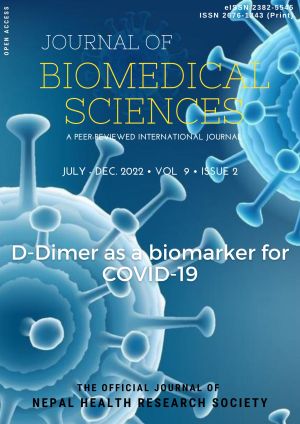D-Dimer as a biomarker for COVID-19 patients' illness severity and mortality: A hospital-based study from eastern Nepal
DOI:
https://doi.org/10.3126/jbs.v9i2.52048Keywords:
COVID-19, Reactive Protein, D-Dimer, NepalAbstract
Background: The biomarker D-dimer, produced when fibrin breaks down, is frequently used to diagnose thrombotic diseases. D-dimer has been recognized as a potential indication of the prognosis for COVID-19 patients since the inception of the COVID-19 pandemic. We collected and compared the demographic, clinical, and liver function data of patients with confirmed COVID-19 at admission between those with elevated and those with normal D- dimer levels in our hospital-based study.
Material and methods: A hospital-based study that used data from the biochemistry laboratory at Birat Medical College Teaching Hospital in Biratnagar, Nepal, was conducted between July 31 and December 31, 2021. Measurements included age, gender, D- Dimer, procalcitonin, C- Reactive Protein (CRP), aspartate transaminase, and alanine transaminase.
Results: In COVID-19 patients with normal D-dimer levels, the mean age was 55 years (CI, 43-67), while in those with increased levels, it was 66 years (CI, 52-80). In the increased group of the D- dimer, almost 20% had diabetes mellitus, and 8% had chronic obstructive pulmonary disease. Compared to the normal group, the mean values of D- Dimer, procalcitonin, C- Reactive Protein (CRP), aspartate transaminase, and alanine transaminase, alkaline phosphate in the raised group were noticeably higher.
Conclusion: In conclusion, SARS-CoV-2-infected individuals frequently have high D-dimer levels. Critically sick patients had much greater levels, which can be utilized as a predictive indicator for in-hospital mortality.
Downloads
Downloads
Published
How to Cite
Issue
Section
License
Copyright (c) 2022 Ankush Mittal, Mohammad Shamim Farooqui

This work is licensed under a Creative Commons Attribution 4.0 International License.
This license enables reusers to distribute, remix, adapt, and build upon the material in any medium or format, so long as attribution is given to the creator. The license allows for commercial use.




